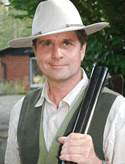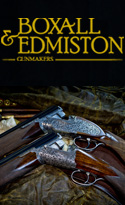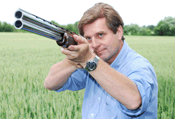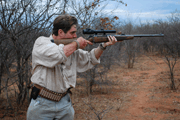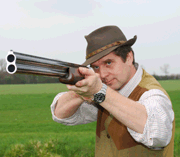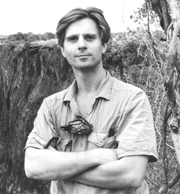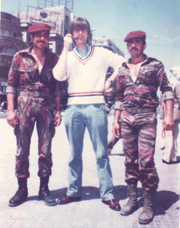Foot Position - How to Position Your Feet When Shooting
Whatever discipline we may be shooting, a good stance provides the platform for a consistent, unimpeded swing. In particular, a good stance provides good balance throughout the mount, swing and follow-through, something rarely achieved with wide spaced feet, excessively bent legs, or a protruding butt (yours not the gun). Without any doubt, good footwork, is critical to good shooting. Yet, watch people shooting clays or live birds, and you will see that they are often out of balance at the moment as the shot is taken. Typically, they run out of swing through poor technique or poor preparation and are forced to compensate with the most ungainly body positions. How should we stand? Let us look at the classic styles first.
The English shooting instructor, Percy Stanbury, famously advised (for game, sporting clays, skeet and trap) a stance where the weight was kept on the front (left) foot throughout the shooting process (this applied whether the shot was right or left or being driven overhead at considerable height). The general attitude he noted was that of "a half turn to the right front" with the chest at "an angle of about 45 degrees to the line of fire." There is a slight forward lean in Stanbury's position and the rear (right) heel is slightly lifted. The front leg is kept straight and acts as a pivot so that hips may move right or left with ease (generating the power for the swing). The heels are 6-9" apart. If the shooter stands on a clock-face his front foot will be positioned at 1 and his rear foot at 3 o'clock
Robert Churchill, a no less famous English instructor, was of very different build to Stanbury, and suggested a quite different way of standing. The Churchill stance is squarer, with the heels even closer ("about three or four inches apart"). With Churchill's stance - which has been much publicised in the States - one transfers weight on to the right foot for a shot to the right and on to the left for a shot to the left. Between shots the weight is evenly supported on both legs. On the clock-face the starting position for this stance would have the left foot at about half past 11, and very slightly forward, and the right foot somewhere near 1.
At first glance, there would seem little room for compromise between the two. Stanbury describes standing too square as an error and Churchill, placing the right foot behind the left (which he suggests prevents the butt sole firmly locating at the shoulder). But, when one reads between the lines and experiments with both styles, one discovers that they have something in common - the attempt to achieve balance and free movement. Churchill even admits that when using heavy guns or guns with heavy charges "a greater proportion of the weight may be thrown on to the front leg". Both men may have exaggerated their positions for ease of description, and have created stances which suited their body types and shooting style. That is what every shooter must do too, rather than blindly accepting one dogma or another.
I shall add another stance into our consideration now. It has been called 'the Guinness Stance' by my friends Peter Croft (former European Olympic Trap Champion and ex-World Champion at Universal Trench) and Ken Davies (Chief Instructor at Holland and Holland). It is a very natural position standing as if one was standing at the bar in conversation with a glass of beer in hand. It is not as square as Churchill, but not as oblique as Stanbury. Both legs are relaxed and straight and, critically, the shoulders are positioned above the heels. If one placed a ruler across the toes and another across the heels, moreover, their lines would be parallel. It is an erect, but relaxed and unstrained position and consequently a favourite of some of the best international clay shots. It is also well suited to game shooting.
Another commonly encountered stance - I shall call this one the Modern Stance - also falls somewhere between Stanbury and Churchill. But, in this case, the front knee is slightly bent and lines drawn across the toes and heels would not be quite parallel. The rear leg is straight, both feet are firmly on the ground, positioned at about 12 and 2. This is a slightly more aggressive position than the Guiness stance and, although both feet are firmly planted on terra firma the weight is well forward. The front foot is positioned towards the killing point for the target (sporting and skeet) or the centre of the zone in which targets are to be engaged (trap). In this stable, determined position, the muzzles, front hand and and front knee all point together as one swings. The 'cracked' front knee acts as pivot, and the rear leg keeps you in balance and helps to drive you through the shot.
Anyone who wants to improve their shooting style should experiment. No book or article can tell you what precisely is right for you. For clay shooting - trap, skeet or sporting - I tend to prefer the modern or Guiness stances, they are both very stable and can provide good foundations for a long run of kills. When shooting live birds, I tend to use Stanbury's style more than any other. But, when I am forced into very hot corners, where there is no time to move the feet, I often revert to Churchill's footwork. Whatever one's body type, it is then a most efficient way of dealing with fast unpredictable birds breaking right and left (and this might apply to clays in a 'flush' style competition or live birds being riven towards you).
Your feet should not be set in blocks of concrete, you may find that you need to adjust your stance for specific situation. Some prefer to be closer footed for high birds than for lower ones. Similarly, you may find that you prefer to crack one, or even both knees for low birds (many Olympic Skeet shots bend the knees slightly), but not for high ones. If, in any given situation, your stance allows you to be in balance and minimises tension in the swing at the moment you pull the trigger it is probably right. If it feels unstable and/or restricts the swing it is almost certainly wrong. Whenever possible, the stance should be orientated towards the killing point for the target (or, in the case of trap shooting) towards the middle of zone in which birds are to be engaged. We will discuss this in more detail at a later date, but for now, let us end by noting that the intelligent shot always positions himself so that he can engage the target with minimum tension and maximum balance.
ALWAYS HANDLE GUNS AS IF THEY ARE LOADED
British, close-footed, shooting styles have been deeply influenced by European style driven game shooting in which there was little walking and the arc of presentation of the targets was fairly predictable. Interestingly, if one looks at eighteenth or early nineteenth century British shooting prints - an era before the introduction of driven shooting as now practised - one sees a much wider, edge on, style. In the United States, where walking up birds over dogs is still the norm when hunting, this style of standing is still quite common. Rifle shooting has also had a profound effect on this side of the Atlantic. It tends to encourage a style of shooting where the feet are wide spaced and the weight is evenly distributed on both legs. One can get a way with such a position when walking up partridge, grouse or quail, but is does not encourage a good swing on crossing birds or clays.
High birds
Some will bow the body and keep the weight on the front foot when taking a bird above. Some will move onto the back foot for all overhead shots. Some will transfer the weight as per Churchill's advice, depending on the side the shot is taken. Some will keep their centre of gravity between the feet. I have no preferences as far as my clients are concerned, it is a question of what allows them to stay in balance best whilst pushing in front of the target. For my own shooting, I prefer to keep the weight on the front foot throughout the overhead swing, but there are days when my back will not allow it!
For more on High Birds Click here.


